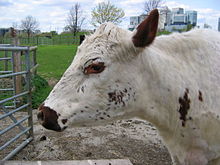City farm
This article needs additional citations for verification. (January 2012) |
| Agriculture |
|---|
 |
|
|
City farms are usually community-run projects in urban areas, which involve people interacting and working with animals and plants. They aim to improve community relationships and offer an awareness of agriculture and farming to people who live in built-up areas.
They vary in size from small plots on housing estates to larger farms that occupy a number of acres. It is estimated that more than three million people visit city farms each year and around half a million people work on them as volunteers.[citation needed] Although some city farms have paid employees, most rely heavily on volunteer labour, and some are run by volunteers alone. Others operate as partnerships with local authorities. In London the city farms now have a show at an agricultural college called Capel Manor every September.
City farm also refers to "City Farm," a three quarter acre bio-intensive farm on the Southside of Providence, Rhode Island. This is one element of the Southside Community Land Trust. At the City Farm, crops are grown both for donation to local charities and for selling at local farmers' markets. The City Farm is also a site where children's groups from the Greater Providence area come for education on organic local farming.
Purpose and aims

City farms can allow urban dwellers to interact with farm animals and crops. For some people who may never visit a rural farm this provides a chance to see how farm animals are raised and to make the link between 'agriculture' and 'food'. They provide a focus for educational, environmental and conservation activities.
History
During the 1960s a number of community gardens were established in the United Kingdom, influenced by the community garden movement in the United States. The first city farm was set up in 1972 in Kentish Town, London. It combined farm animals with gardening space, an addition inspired by children's farms in the Netherlands. Other city farms followed across London and there are now over sixty city farms in the United Kingdom. In Australia, several city farms exist in various capital cities. In Melbourne in 1979 the Collingwood Children's Farm was established on the Abbotsford Precinct Heritage Farmlands (the APHF), the oldest continually farmed land in Victoria, farmed since 1838.
Similar concepts
There are also around a thousand community gardens and seventy-five school farms in the UK. Together with city farms they are represented by The Federation of City Farms and Community Gardens. The Access to Farms scheme is a project to enable educational access to working farms. Allotments also provide agricultural space for individuals and groups within urban areas.
See also
- Allotment gardens
- Asset-Based Community Development
- Collingwood Children's Farm
- Community Food Security Coalition
- Community gardens
- Container garden
- Ecological sanitation
- Intercultural Garden
- Living wall
- Meanwood Valley Urban Farm
- Permaculture
- Rooftop gardens
- Sheet mulching
- Sustainable agriculture
- Vertical farming
References
- Pinderhughes, Raquel (2004). Alternative urban futures: planning for sustainable development in cities throughout the world. Lanham: Rowman & Littlefield. pp. 185–217. Retrieved January 15, 2012. ISBN 0-7425-2366-7
